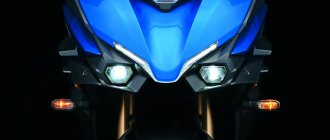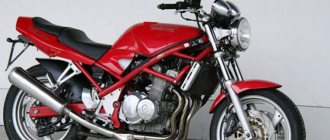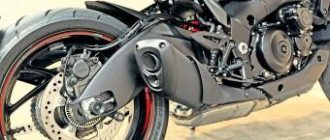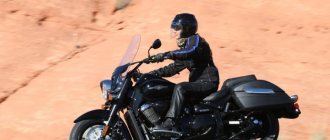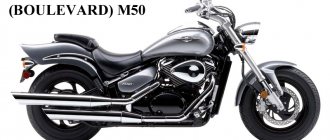| Suzuki GSX-S1000 (2015-2020) | Suzuki GSX-S1000 (2022+) | Suzuki GSX-S1000F (2015-2020) | Suzuki GSX-S1000GT (2022+) |
Suzuki GSX-S1000 naked model
was first presented in 2014 at the EICMA exhibition, and official sales began in 2015. The company has been developing this model for quite a long time, wanting to expand the GSR series with the flagship model Suzuki GSR1000 - by the way, the concept model was originally called that way. By the way, the 750 cc version also had the name Suzuki GSX-S750, but only for motorcycles outside the European market; in Europe it was sold under the usual name - Suzuki GSR 750. Only in 2022 the name GSR750 was finally removed, giving way to GSX- S750. Thus, the line of naked bikes from Suzuki now belongs to the GSX-S series.
The basis for the Suzuki GSX-S1000 was an in-line 4-cylinder liquid-cooled engine with a volume of 999 cm³ and producing 145 hp. power and 106 Nm of torque. In 2022, the engine was slightly modified and modernized to meet new environmental standards. The maximum power of versions from 2022 is 150 hp.
Other features of the Suzuki GSX-S 1000 include an aluminum frame, adjustable sports suspension, powerful 4-piston radial brakes with ABS, a traction control system (3-stage), a 17-liter fuel tank and a curb weight of 207 kg.
2020 was the final year of production for the Suzuki GSX-S1000 and Suzuki GSX-S1000F. The model was not produced in 2022, and at the end of the year the company introduced the new generation Suzuki GSX-S1000
2022 model year and a new modification
Suzuki GSX-S1000GT
, designed to replace the GSX-S1000F. The new generation received an updated appearance, full LED optics, minor changes to the engine (+ 2 hp in power), a 19 liter fuel tank (instead of 17 liters), as well as new electronic equipment - 3-level Suzuki Drive Mode Selector, new generation Traction Control System (5 levels, instead of 3), Quick Shift system (down and up), 6.5-inch color display (GSX-S1000GT), cruise control (GSX-S1000GT) and smartphone connection system Suzuki mySPIN (GSX-S1000GT).
Electronic systems Suzuki GSX-S1000:
- ABS
- Electronic gas (Ride-by-Wire system)
- SDTV (Suzuki Dual Throttle Valve)
- Suzuki Clutch Assist System
- Traction Control System (3-mode)
- Low RPM Assist
- Suzuki Easy Start System
- Full LED optics - 2022+
- Suzuki Drive Mode Selector (3-mode) – 2022+
- Traction Control System (5-mode) – 2022+
- Quick Shift system (up/down) - 2022+
- 6.5" TFT color display - GSX-S1000GT
- Cruise Control - GSX-S1000GT
- Suzuki mySPIN (smartphone connectivity system) - GSX-S1000GT
In 2022, based on the Suzuki GSX-S1000, a new model was built, which became the reincarnation of the Katana series, produced in the 80s of the last century - Suzuki Katana 2022.
The main competitors of the Suzuki GSX-S1000 in the class:
- Honda CB1000R
- Kawasaki Z1000
- Yamaha FZ-1/Yamaha MT-10
Brief history of the model
- 2015 - start of production and sales of Suzuki GSX-S1000 and Suzuki GSX-S1000F.
Model
: Suzuki GSX-S1000 +ABS;
Suzuki GSX-S1000F + ABS (all regions). Factory designation
: GSXS1000L5, GSXS1000AL5; GSXS1000FL5, GSXS1000FAL5.
- 2016 - no significant changes.
Model
: Suzuki GSX-S1000 +ABS;
Suzuki GSX-S1000F + ABS (all regions). Factory designation
: GSXS1000L6, GSXS1000AL6; GSXS1000FL6, GSXS1000FAL6.
- 2017 - the model receives modifications to the engine, increasing the maximum power to 150 hp. and meeting updated environmental requirements.
Model
: Suzuki GSX-S1000 +ABS;
Suzuki GSX-S1000F + ABS (all regions). Factory designation
: GSXS1000L7, GSXS1000AL7; GSXS1000FL7, GSXS1000FAL7.
- 2018 - no significant changes.
Model
: Suzuki GSX-S1000 +ABS;
Suzuki GSX-S1000F + ABS (all regions). Factory designation
: GSXS1000L8, GSXS1000AL8; GSXS1000FL8, GSXS1000FAL8.
- 2019 - no significant changes.
Model
: Suzuki GSX-S1000 +ABS;
Suzuki GSX-S1000F + ABS (all regions). Factory designation
: GSXS1000L9, GSXS1000AL9; GSXS1000FL9, GSXS1000FAL9.
- 2020 - no significant changes.
Model
: Suzuki GSX-S1000 +ABS;
Suzuki GSX-S1000F + ABS (all regions). Factory designation
: GSXS1000M0, GSXS1000AM0; GSXS1000FM0, GSXS1000FAL9.
- 2021 - model not produced.
- 2022 - new generation Suzuki GSX-S1000. The touring modification of the Suzuki GSX-S1000F is being replaced by a new one - the Suzuki GSX-S1000GT.
Model
: Suzuki GSX-S1000;
Suzuki GSX-S1000GT (all regions). Factory designation
: GSXS1000M2; GSXS1000GTM2.
The Hidden Menace: Test Drive the 2022 Suzuki GSX-S1000F
The recipe for making hot roadsters is the same all over the world: take a flagship sportbike, remove the plastic, replace the clip-ons with a regular wide handlebar, deboost the engine and voila - a new liter naked is ready. This is exactly the way Suzuki went, rolling out the new GSX-S1000F, which differs from the “simply” GSX-S1000A in its developed “tail” and a 100 thousand rubles larger price tag. It was the GSX-S1000F that we decided to try.
Everyone is guilty of building sports roadsters: Aprilia sells the Tuono, created on the basis of the RSV1000, BMW is not shy about the close relationship between the S1000R and the S1000RR, Yamaha offers the MT-10, built on the R1 chassis, Kawasaki has the Z1000 based on the flagship Ninja, a list of only models released today I could go on for a long time, but there are some that have already been discontinued!
Road motorcycle Suzuki GSX S1000F
But most of them are based on the chassis of the current generation of the flagship sportbike, while Suzuki engineers apparently thought: why waste it? Let's build a roadster based on the previous generation of the Jixer? And they built it! While the new liter GSX-R1000 pleases its new owners with its bells and whistles, fans of hot naked bikes have to wear out the old platform. However, is a new one needed here? Maybe the old one is good? Looking ahead, I’ll say it’s good, but we’ll get to that a little later. In the meantime, let's look at this predator up close.
The GSX S1000F is based on the time-tested platform on which the previous generation of Jixers was built.
The design is bright and original, the head optics are good and, more importantly, unusual. But everything else is quite Japanese and common, it seems that everyone should like the motorcycle. But in reality, opinions are divided - some like the appearance of the device, others absolutely do not. In any case, and this, in my opinion, is the main advantage of the GSX-S1000F - it does not leave anyone indifferent. Remember how much heated debate there was around the GSX1300R Hayabusa? That's the same!
The appearance of the new GSX-S1000F will not leave anyone indifferent
The main thing is that it’s really comfortable behind the wheel: the seat cushion is unusually comfortable and soft for motorcycles of this class, the height is not annoying, the steering wheel is moderately wide - the ergonomics are thoroughly checked! And even though the wind protection, despite the plastic, is rather weak, it’s a city motorcycle, but it’s forgivable. But the remote controls are a masterpiece, there are not many buttons, everything is in its place, the quality is high, and the design is pleasing.
The remote controls are made with Japanese meticulousness and make a pleasant impression
It’s just a pity that the holiday of Japanese harmony is overshadowed by a flashing monochrome dashboard with white backlight. The tiny display is overloaded with information, and the tape tachometer is lousy to read. And although the functionality is decent: speed, revolutions, gear engaged, fuel level, mileage, clock and choice of traction control operating mode, nowadays you expect more from the dashboard.
The instrument panel is the most unsightly part of a motorcycle, and although the functionality is decent, it is extremely inconvenient to read
As if apologizing for the simplicity of the instrumentation, the Japanese supplemented the motorcycle with two unique systems that competitors do not have. The first allows you to start the engine with one touch of a button, after which the starter turns the engine automatically until it starts, the second allows you to slightly add gas when starting at traffic lights and in traffic jams. Both work, but the latter, although it helps, still does not forgive a sudden drop of the clutch.
The engine start system with one touch of a button is a nice and convenient feature that competitors do not yet have
In addition, the GSX-S1000F has traction control, ABS and... In fact, that’s all it has. No quick shifters, cruises, electronic suspensions, heated grips or other nonsense. But there is nothing to break, and those systems that exist can boast of their outstanding operating algorithms, which we will return to a little later, but for now, let's go!
Switching between operating modes and menu navigation is carried out using switches on the left remote control
A perfectly working gearbox in Japanese style brings out a tear of nostalgia for old devices from the land of the rising sun, switching, lever travel, effort - everything is perfect. Even the sound of turning on the “first” can be used as an example! The cable-driven clutch feels great, the force on the lever is pleasant, it couldn’t be any other way on a Japanese motorcycle.
The GSX-S1000F gearbox can be called a reference
But the engine... Turning the throttle all the way does not make the motorcycle go at all. Four, five, six thousand revolutions, the tachometer tape creeps as lazily as the motorcycle picks up speed. Seven. Explosion, spark, storm, madness. The motorcycle hits the rear wheel, which barely manages to catch the traction, literally shooting into the horizon. The muzzle lowers only when the tachometer readings approach 13 thousand revolutions, at which the cutoff occurs.
The GSX-S1000F uses an inline four-cylinder engine with a displacement of 999 cm3 as a power unit.
It seems that the engine was derated to 150 horsepower, but the sportbike character with “meat” at middle and upper speeds was not changed at all in favor of the “lower” ones. You need to twist it and then it will be amazing, but at an average pace - alas and ah. All or nothing, either very slowly or keep me seven. And all this accompanied by a bright and rich exhaust sound, alternately reminiscent of the roar of a Formula One car or the howl of a Typhoon vacuum cleaner. It’s not often that a standard muffler turns out to be so melodious, and drivers move apart in traffic.
The fairing adds stability in corners, creating additional downforce
Suzuki GSX-S1000F provokes you to spend all your money, but at the same time delicately controls the process. Traction control is tied not only to wheel rotation sensors, but also takes into account the gear engaged, throttle angle and speed. In addition, the system, which the Japanese themselves call Suzuki Traction Control II, allows the pilot to choose one of three intervention modes or turn it off completely. And even though, unlike modern devices with electronic throttle valves, it “cuts” the ignition, the interventions are very delicate and unobtrusive. Especially in mode “1”, where the motorcycle confidently rolls on the rear wheel, with almost no risk of tipping over backwards.
The muffler is modest, but it sounds just right; you can change it to a forward flow one only for reasons of weight saving
The second mode is a little more attentive in the “wheelie” and allows you to only slightly lift your face off the asphalt, and the third completely cuts off any slippage and separation of the front wheel in the bud - just right for driving on wet and cold Moscow asphalt. But you don’t want to turn it off completely, except to burn rubber, nothing more - the “number one time” mode is enough to get adrenaline.
The first thing I want to do is unscrew the reflectors on the front wing.
The chassis of the Suzuki GSX-S1000F is also hard to fault: an aluminum diagonal frame, an aluminum double-armed swingarm, a fully adjustable monoshock absorber with an “upside-down” - a classic of the genre. On the move, the chassis is not too sharp, but not bland either; there is enough rigidity, but no more. Without revelations and very harmonious, and against the backdrop of incredibly tough and sharp competitors it is also original, but if classmates envy the comfort of driving around the city, then the Suzuki will not leave a chance on any track.
The suspensions are fully adjustable, but only manually - electronics are not even in the plans
The brakes make a similar impression - Brembo calipers effectively stop the vehicle from any speed, but feedback, especially from the front, is sorely lacking. Hoses without fittings swell, and the brake machine itself is far from ideal, just like the lever adjustment knob, which changes its position due to vibrations. ABS saves you, you can simply hit the lever and pedal, enjoying the chirp of modern anti-lock. For the city - ok, for the track - not so much.
The Brembo brakes are good, but they lack feedback. The standard ABS system saves the day
The motorcycle does have vibrations, but they reach the steering wheel quite late and generally do not irritate, the rear-view mirrors are standard, but the passenger perch is modest, although again, within the laws of the genre. Is it a good motorcycle? Undoubtedly! The lag in electronics is more than compensated for by harmony, and for driving around the city the existing set is quite enough, and in other respects the device is ideally adapted to the concrete jungle. Impressions are mixed - many will envy the comfort, but the Suzuki GSX-S1000F will give you much less emotion and adrenaline than its classmates.
Video review of the Suzuki GSX-S1000F 2017 motorcycle:
Photos of Suzuki GSX-S1000F 2017:
Thank you for providing the motorcycle for testing.
Accreditation and organization of test drives – Denis Sokolov | | +7 (999) 851-49-71
Photos in the article – Alexander Batyru
Photos
| Suzuki GSX-S1000 (2015-2020) | Suzuki GSX-S1000 (2015-2020) | Suzuki GSX-S1000 (2015-2020) |
| Suzuki GSX-S1000 (2022+) | Suzuki GSX-S1000 (2022+) | Suzuki GSX-S1000 (2022+) |
| Suzuki GSX-S1000F (2015-2020) | Suzuki GSX-S1000F (2015-2020) | Suzuki GSX-S1000F (2015-2020) |
| Suzuki GSX-S1000GT (2022+) | Suzuki GSX-S1000GT (2022+) | Suzuki GSX-S1000GT (2022+) |
Review
The Suzuki GSX-S1000 naked model was first presented in 2014 at the EICMA exhibition, and official sales began in 2015. The company has been developing this model for quite a long time, wanting to expand the GSR series with the flagship model Suzuki GSR1000 - by the way, the concept model was originally called that way. By the way, the 750 cc version also had the name Suzuki GSX-S750, but only for motorcycles outside the European market; in Europe it was sold under the usual name - Suzuki GSR 750. Only in 2022 the name GSR750 was finally removed, giving way to GSX- S750. Thus, the line of naked bikes from Suzuki now belongs to the GSX-S series.
The basis for the Suzuki GSX-S1000 was an in-line 4-cylinder liquid-cooled engine with a volume of 999 cm³ and producing 145 hp. power and 106 Nm of torque. In 2022, the engine was slightly modified and modernized to meet new environmental standards. The maximum power of versions from 2022 is 150 hp.
Other features of the Suzuki GSX-S 1000 include an aluminum frame, adjustable sports suspension, powerful 4-piston radial brakes with ABS, a traction control system (3-stage), a 17-liter fuel tank and a curb weight of 207 kg.
Specifications
Technical specifications of Suzuki GSX-S1000 / GSX-S1000F / GSX-S1000GT:
| Model | Suzuki GSX-S1000 |
| Motorcycle type | naked |
| Year of issue | 2015+ |
| Frame | aluminum |
| engine's type | 4-cylinder, 4-stroke, in-line |
| Working volume | 999 cm³ |
| Bore/Stroke | 73.4 x 59.0 mm |
| Compression ratio | 12,2:1 |
| Cooling | liquid |
| Number of valves per cylinder | DOHC, 4 valves per cylinder |
| Fuel supply system | injector with SDTV (Suzuki Dual Throttle Valve), 4x |
| Ignition type | fully transistorized |
| Maximum power | 145.0 hp (106.0 kW) at 10,000 rpm – GSX-S1000/F (2015-2016) 150.0 hp (110.0 kW) at 10,000 rpm – GSX-S1000/F (2017-2020) 148 hp (109.0 kW) at 10,000 rpm - GSX-S1000 / F (2017-2020, Japanese market versions, frame number GT79B*) 152.0 hp (112.0 kW) at 11000 rpm – 2022+ |
| Maximum torque | 106.0 Nm (10.7 kg*m) at 9500 rpm – GSX-S1000 / F (2015-2016) 108.0 Nm (10.9 kg*m) at 9500 rpm – GSX-S1000 / F (2017-2020) 107.0 Nm (10.9 kg*m) at 9500 rpm – GSX-S1000 / F (2017-2020, Japanese market versions, frame number GT79B*) 106.0 Nm (10.8 kg*m) at 9250 rpm - 2022+ |
| Clutch | Multi-disc in oil bath, cable drive |
| Transmission | 6-speed |
| type of drive | chain |
| Front tire size | 120/70ZR17 M/C (58W) |
| Rear tire size | 190/50ZR17 M/C (73W) |
| Front brakes | 2 x 310mm discs, 4-piston radial calipers (ABS) |
| Rear brakes | 1 disc 250 mm, 1-piston caliper (ABS) 1 disc 240 mm, 1-piston caliper (ABS) - 2022+ |
| Front suspension | 43mm inverted fork (fully adjustable), 120mm travel |
| Rear suspension | pendulum with monoshock absorber (7-step preload adjustment, rebound adjustment), stroke - 130 mm |
| Length | 2115 mm 2140 mm - GSX-S1000GT |
| Width | 795 mm 810 mm - GSX-S1000 (2022+) 825 mm - GSX-S1000GT (2022+) |
| Height | 1080 mm – GSX-S1000 1180 mm – GSX-S1000F 1215 mm - GSX-S1000GT (2022+) |
| Wheelbase | 1460 mm |
| Minimum ground clearance (clearance) | 140 mm |
| Seat height | 810 mm |
| Acceleration 0-100 km/h (0-60 mph) | 3.14 sec[1] |
| Maximum speed | 255 km/h[2] |
| Gas tank capacity | 17.0 l 19.0 l – 2022+ |
| Motorcycle weight (curb) | 207 kg – GSX-S1000 (2015-2020) 209 kg – GSX-S1000A (ABS) 212 kg – GSX-S1000F 214 kg – GSX-S1000F (ABS), GSX-S1000 (2022+) 226 kg - GSX-S1000GT (2022+) |
As promised, with a slight delay, I’m writing something like a review on the GSX-S1000F. Test drives, full reviews with descriptions of characteristics, fillings and other things can be found on the Internet, so these are rather my feelings. No more. The idea to change the class has been around for a long time. I found sports to be quite boring, at least in the city. Initially I wanted a tourenduro, but most of them are cow-like, heavy, on a cardan. You can understand the advantages of such technology, but do not buy it for yourself. Except for the ADVENTURE 1190 and the new multistrada. You can have some fun with this. But I couldn’t find an adventure game that I really wanted to buy. There are a lot of them in the “R” modification on 21 wheels, in panniers, and so on. No longer needed. And the multistrada scared me off with the price tags both for the moped itself and for the service. Maybe these are partly fairy tales, but I just don’t have the energy, time or money to check for myself.
As a result, it was decided to look for a motorcycle in the street class. Standard Japanese options like CB1000R, FZ1, Z1000(SX) were immediately discarded. The CB1000R didn't make the cut due to its weight, lack of wind protection and overall dull appearance. I didn't like the FZ1 due to its fit and rather sparse equipment by modern standards. And the moto itself, in place, seems quite wide and... heavy or something. I counted so many disadvantages in the Z1000 that I have never been able to find in one motorcycle at once. Here the weight is about 230 kg and the fork is 41 mm and brake discs up to 13 years are 300 mm. And the thickness of the pendulum is laughable, as if this is not a street (sports tour) with a large engine, but a budget road bike for beginners. Fortunately, they covered it with two huge cans. Next we looked at the Tuona and S1000R. The motos are undoubtedly very cool, but the design did not go beyond the word at all, at all. Well, what would it be without the Superduke 1290. I still want it, but it’s the second generation. This is just the perfect street, in my opinion. But I didn’t save up for it, so it’s also a miss. Someday later, probably. By the way, a pleasant plus of the Superduke is that spare parts are actually not as expensive as is commonly believed. Everything is within reason when it comes to magura and brembo.
The choice turned out to be quite obvious - GSX-S1000F. Although it is still not clear to me why this motorcycle is not popular. From what I needed in a motorcycle, without which I would not consider a street bike, with rare reservations - a rigid aluminum frame, a rigid pendulum, preferably from a sport. Not a bad engine, at least 140 horsepower. The suspension is not from Alpha, it is adjustable. ABS, in my opinion, is a mandatory attribute for a motorcycle in the city. Well, I wanted a motorcycle with traction. And here it’s almost a 100% hit, except that the rear shock should not be on this motorcycle, but go to the landfill. But the engine, according to measurements that I Googled, in stock, shows about 140 hp at the wheel.
This all sounds good, doesn't it? But how does it actually feel? Let's start with landing. Everything is individual here, of course. But I liked it right away: you sit with a slight tilt forward, the steering wheel is wide and the fatbar is wide, but not so much that it gets in the way between the rows. The angle and placement of the legs is somewhere between sport and road. In my opinion, the footrests could have been moved back. What I immediately noticed as a plus was that the seating position is not like on some road car, relaxed and sofa-like, but quite sets you up for a vigorous pace of driving. The dashboard is informative and clear, everything you need is present. There is also a normal fuel level indicator in the form of a scale, average consumption per 100 km and mileage per 1 liter of fuel. Clock, speedometer and tachometer, mileage. All menu navigation is carried out using three buttons on the remote control. What else does? Unless it’s a bastard engine temperature indicator made up of five sticks, from which you’ll never know whether the engine has warmed up, how much it’s warmed up, and all that. It still infuriates me, it infuriates me especially now when it’s cold. I had to come to terms with it. The electronic tachometer caused discomfort for the first few days, now I’m unlikely to want a dial one. Once again, it is worth noting that the remote controls are very convenient. I poked and prodded a lot. But these are probably my favorites so far. All buttons are exactly where they should be. You don’t have to bend your fingers unnaturally and become blunt when trying to turn on the long range or switch the traction mode on the go. For this, great respect. The seat seems comfortable and soft. The first thirty minutes. Then the realization comes that you are sitting on your balls and your entire groin is numb. You have to either move back or change the seat. Apparently I'll have to worry about this. Perhaps this is some kind of individual problem. The passenger seat is not much different from its counterparts on sports. And the seating position for the passenger is similar.
Next, I want to make a digression and immediately outline. This motorcycle can be taken for quiet rides around the city and outside the city, hung with panniers, high windows, equipped with touring tires, heated grips along with an ass warmer, and ridden on asphalt long-distance roads. This is the first option. Or make it into a racing gun for night shooting around the city. Because this is, damn it, a jixer with a straight rudder.
On the move, in stock, the motorcycle feels rather strange. The engine runs great from the bottom up, up to 6 thousand. You can drive around the city all day and never feel like you need more. At the same time, 90% of the time you drive in 5-6 gears. I did this for exactly a week. Afterwards, I discovered that it handles like scum and, thanks to the 1460mm base, even if it explodes in the rear, it is very stable and predictable. Acceleration from 0-200 km/h really impressed me, I didn’t expect it. So far I haven’t had many races, but having more or less learned how to start, I have no problems overtaking a litrosport or a motorcycle of a similar class. And it’s really fun, especially when you don’t expect anything special from a motorcycle of this class.
The suspension is tuned for a very relaxed rider who wants to ride in comfort and doesn’t even want to think about cornering. Over time, it became clear why Suzuki did this. The five in the fork is not without reason, it’s saving money. There is hardly any other meaning to this. The rear shock, so that those who put it there would burn in hell, does not allow for normal suspension adjustment. Its adjustments are simply not enough to achieve suspension characteristics similar to sports ones. I had to cool my fucking down a little and put up with a little swaying in turns and on bumps. But do you think these are all the problems that will await those who decided to make a racing gun? No. Then wobbling begins, constantly, on uneven surfaces, joints, and markings. And just tuning and changing the oil from 5w to 10w. This is due to the lack of a damper. After all, in the five, in the fork, and without adjusting the suspension, it is still felt. To summarize the above: you can take it and ride it calmly, shooting in straight lines and riding on roads with an average quality surface. There's enough here for the eyes and even more. Or if you need a motorcycle that gives you emotions, then get ready to spend around 100k and get a very fun bike for not much more money by today’s standards.
Well, probably the readers, if anyone is reading this at all, have already guessed that I followed the gun-racing path.
The first thing that went to the dump was the exhaust, its place was taken by a full M4 exhaust, along with a healtech servomotor emulator. The sound added +30 points of driving pleasure, took away up to 5 thousand. noticeably from the bottom and began to press the brain to the back of the skull after 8 thousand. A BMC low-resistance filter was subsequently purchased for the exhaust. Next came the noname brackets for the running boards, which are a couple of cm higher than the drain. And they still managed to rub the asphalt twice in the city in slow turns, apparently I’ll have to continue working on collective farms and think about how to put them even higher. Well, the most expensive thing that had to be installed was the TOBY damper. It was obvious that he was needed. But having caught a pretty big wobble on the embankment at full throttle, the damper was ordered that same evening. I’ll say right away that after installing it on the motorcycle, I don’t even remember about wobbling. The rest of the little things, in the form of black glass, turn signals, stickers on the tank, a thrown away shovel for an aggressive appearance and a pleasant chill under the collar in the rain, etc., etc., can be ignored. This is a matter of taste. Now the plans are to rebuild the engine, change the rear shock and get rid of the stock mirrors. They are too wide, and they are located high and protrude a couple of centimeters beyond the steering wheel. I use them 24/7, all in a row. And of course I want lenses, but I’m unlikely to be able to decide on that. Road, but beautiful. And I'll end with some advice. If you want to make something similar from GSXS, then buy a sport. Will be cheaper. Making street a sport is not as easy as it seems. But at least it became a little fun.
Electronic systems Suzuki GSX-S1000:
Traction control - controls engine traction (OFF - off; 1-sport mode; 2-city driving mode; 3-wet or cold asphalt mode).
Suzuki Easy Start - allows you to start the engine with just one short press on the starter button.
Low RPM Assist - helps you get off the road easily by automatically raising the engine speed if it is not enough.
ABS - The BOSCH ABS unit prevents the wheels from locking when braking.
SCAS - slipper clutch - prevents the rear wheel from locking up when downshifting sharply.
